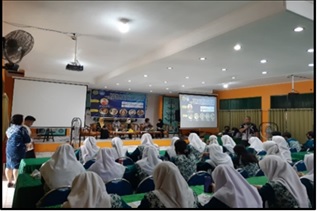Pengenalan dan Pemanfaatan Tanaman Penghasil Karbohidrat Non Beras dan Gandum sebagai Bahan Dasar Usaha Kuliner untuk Siswa Sekolah Menengah Kejuruan Introduction and Utilization of Non-Rice and Wheat Carbohydrate Yield Plants as Based Materials for Culinary Business for Vocational High School Students
Main Article Content
Abstract
Several carbohydrate source plants are well known to the people of Indonesia, seven of which are corn, bananas, sago, cassava, potatoes, sweet potatoes, and taro. Simultaneous efforts by introducing the potential of these plants to be used as culinary products is one thing that can be done. Vocational High Schools (SMK) with culinary expertise can help. Based on this, community service activities were carried out by a team from Palangka Raya University with a target of 40 students and teachers at SMK Negeri 3 Palangka Raya. Activities were carried out by outreach, consultation, interactive discussion, and hands-on practice of introducing and making cakes made from non-rice and wheat, as well as surveys of perceptions. This activity aims to provide socialization about non-rice and wheat carbohydrate source plants, nutritional value, and using safe chemicals for food. After this work was carried out, 51.40% of students were very satisfied, and 90.02% of students understood non-rice and wheat carbohydrate-producing plants and their processing. Students' understanding of the nutrition of non-rice and wheat commodities and the use of safe chemicals increased to 74.85% of the total number of students. Furthermore, guidance is needed so students can promote their culinary products and understand the flow of obtaining SPP-IRT.
Downloads
Article Details

This work is licensed under a Creative Commons Attribution-ShareAlike 4.0 International License.
Authors who publish with this journal agree to the following terms:
- Any article on the copyright is retained by the author(s).
- Author grant the journal, right of first publication with the work simultaneously licensed under a Creative Commons Attribution License that allows others to share work with acknowledgment of the work authors and initial publications in this journal.
- Authors are able to enter into a separate, additional contractual arrangements for non-exclusive distribution of published articles of work (eg, post-institutional repository) or publish it in a book, with acknowledgment of its initial publication in this journal.
- Authors are permitted and encouraged to post their work online (e.g., in institutional repositories or on their websites) prior to and during the submission process, as can lead to productive exchanges, as well as earlier and greater citation of published work.
- The article and any associated published material is distributed under the Creative Commons Attribution-ShareAlike 4.0 International License
References
Bayata, A. (2019). Review on Nutrional Value of Cassava for Use as a Staple Food. Science Journal of Analytical Chemistry, 7(4), 83-91. https://doi.org/10.11648/j.sjac.20190704.12
Dinata, P., Citriadin, Y., & Badrun. (2023). Pendidikan Kewirausahaan Dalam Meningkatkan Life Skill Santri Di Pondok Pesantren Al-Karimiyyah Bodak Barat Lombok Tengah. Manazhim : Jurnal Manajemen dan Ilmu Pendidikan, 5(2), 790-816. https://doi.org/10.36088/manazhim.v5i2.3487
Ginting, E., Utomo, J. S., Yulifianti, R., & Jusuf, M. (2011). Potensi Ubijalar Ungu sebagai Pangan Fungsional. Iptek Tanaman Pangan, 6(1), 116-138.
Hassan, Z. H. (2014). Aneka Tepung Berbasis Bahan Baku Lokal Sebagai Sumber Pangan Fungsional Dalam Upaya Meningkatkan Nilai Tambah Produk Pangan Lokal. Pangan, 23(1), 93-107. https://doi.org/10.33964/jp.v23i1.54
Husna, N. E., Novita, M., & Rohaya, S. (2013). Kandungan Antosianin dan Aktivitas Antioksidan Ubi Jalar Ungu Segar Dan Produk Olahannya. Agritech, 33(3), 296-302. https://doi.org/10.22146/agritech.9551
Indriani, F. (2012). Studi mengenai orientasi inovasi, pengembangan produk dan efektifitas promosi sebagai sebuah strategi untuk meningkatkan kinerja produk. Jurnal Studi Manajemen Organisasi, 3(2), 82-92. https://doi.org/10.14710/jsmo.v3i2.4191
Nurmala, Sinarti, T., Lilianti, E., Jusmany, Emilda, Arifin, A., et al. (2022). Usaha Kuliner sebagai Penggerak UMKM pada Masa Pandemi Covid-19. AKM: Aksi Kepada Masyarakat, 3(1), 65-74. https://doi.org/10.36908/akm.v3i1.458
Rizkhy, P. P., Widianingsih, I., & Pancasilawan, R. (2022). Adaptasi Program Ketahananan Pangan Terhadap Pandemi Covid-19 Di Kota Bandung. JANE (Jurnal Administrasi Negara), 13(2), 195-201. https://doi.org/10.24198/jane.v13i2.37996
Rosidah. (2014). Potensi Ubi Jalar Sebagai Bahan Baku Industri Pangan. TEKNOBUGA: Jurnal Teknologi Busana dan Boga, 1(1), 44-52. https://doi.org/10.15294/teknobuga.v1i1.6403
Sayekti, W. D. (2020). Determinant Factor Of Local Food Consumption Of The Households In Lampung Province. Pangan, 29(2), 127-140. https://doi.org/10.33964/jp.v29i2.469
Sekretariat Kabinet Republik Indonesia. (2021). Hasil Sensus Penduduk 2020; BPS: Meski Lambat, Ada Pergeseran Penduduk Antarpulau. https://setkab.go.id/hasil-sensus-penduduk-2020-bps-meski-lambat-ada-pergeseran-penduduk-antarpulau/
Sianturi, J. F. (2021). Budidaya Tanaman Ubi Jalar dalam Meningkat-kan Ketahanan Pangan Di Desa Banko Lestari Kabupaten Rokan Hilir. Journal Of Community Services Public Affairs (JCSPA), 1(3), 81-86.
Sidiq, F.F., Coles, D., Hubbard, C., Clark, B., & Frewer, L.J. (2021). Sago and the indigenous peoples of Papua, Indonesia: A review. Journal of Agriculture and Applied Biology, 2(2), 138-149. https://doi.org/10.11594/jaab.02.02.08
Tuhuteru, S., Kaiwai, O., Douw, L., Wilil, F., Agapa, I., Kogoya, et al. (2022). Pemberdayaan Masyarakat Kampung Kama Distrik Wesaput dalam Memaksimalkan Singkong dan Ubi Jalar sebagai Solusi Ketahanan Pangan di Masa Pandemik. Jurnal Abdimas Indonesia, 2(1):94-105. https://doi.org/10.53769/jai.v2i1.189
Zelin, O. & Setyawan, H. B. (2019). Pengaruh Macam Bahan Tanam Terhadap Pertumbuhan dan Hasil Tiga Varietas Talas (Colocasia esculenta L.). Berkala Ilmiah Pertanian, 2(3), 122-126. https://doi.org/10.19184/bip.v2i3.16286
